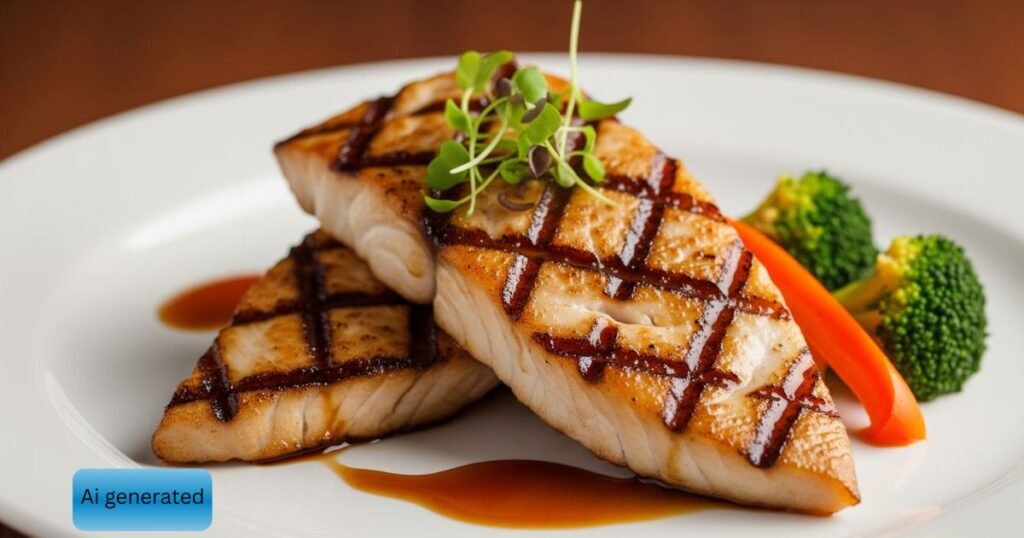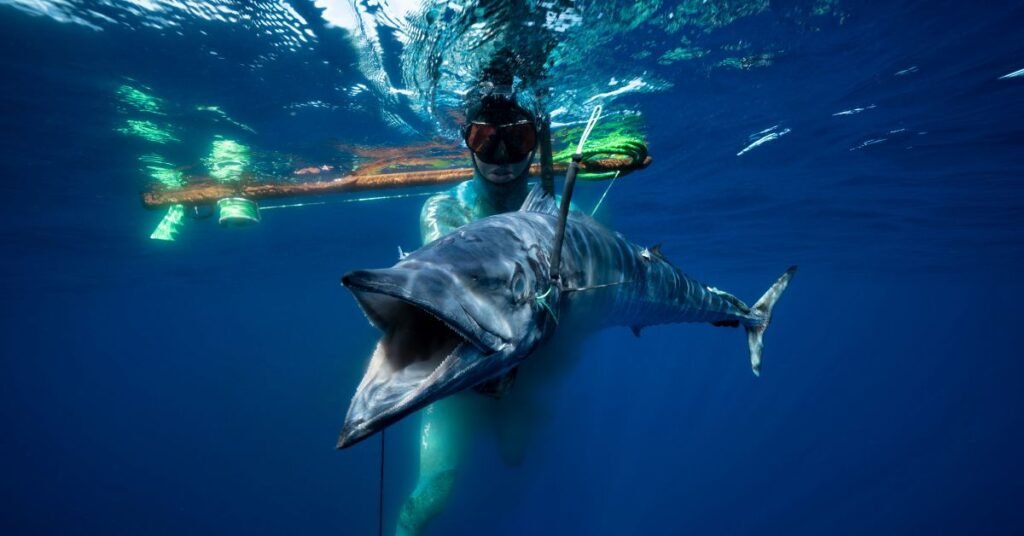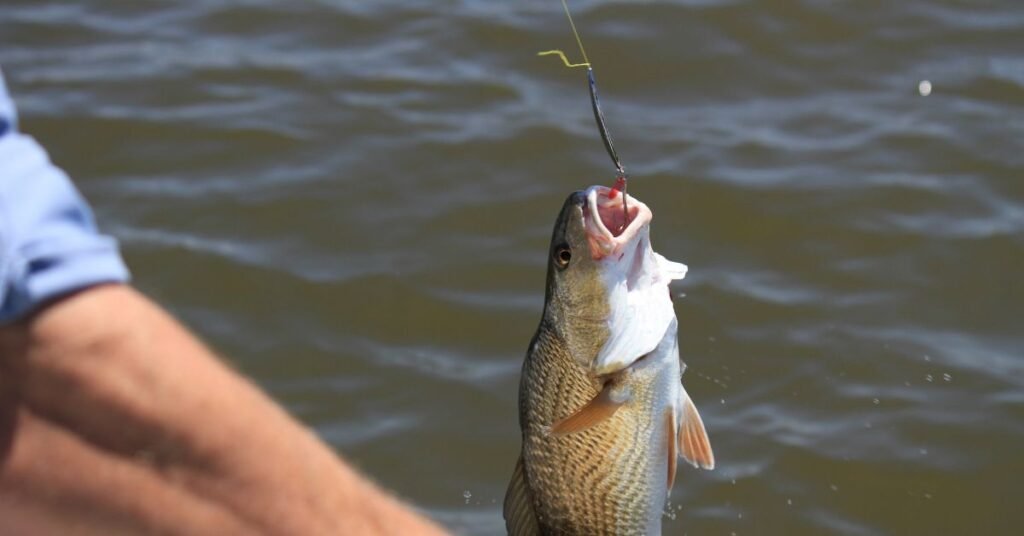If you’ve never heard of the Wahoo (ono), you’re in for a wild ride. This fish doesn’t just swim. It rockets through the water like a torpedo. Its name, Wahoo, comes from Hawaiian and means “good to eat,” and trust me, it lives up to the hype.
Anglers love chasing Wahoo for their speed, fight, and flavor. Some tip the scales at over 100 pounds, though most wahoos caught in Hawaii range from 8 to 30 pounds.
You’ll find them hanging around banks, debris, and surface structures. But they don’t stay put. Longline boats often find their way out in the open sea, proving they like to roam.
Wahoo belong to the same family as tuna and mackerel, and they share that same sleek, no-nonsense look. Deep blue on top, pale underneath, and streaked with vertical bars, they look as bold as they fight. Wahoos are fast, fierce, and often confused with tuna. But are they the same? In this post, I will tell you about what wahoos are, where they live, how they act, what they eat, and why their meat is a favorite in the kitchen.
Table of Contents
Why is Wahoo Popular Among Anglers
Anglers love Wahoo and not just a little. These fish bring the kind of fight that makes your reel scream and your heart race. The moment a wahoo hits your line, you know you’re in for a wild ride.
They’re built for speed. With long, torpedo-shaped bodies and razor-sharp teeth, wahoo doesn’t just swim. They torpedo through the water like missiles. Some even call them the “cheetahs of the sea.” And when one slams into your lure at 60 mph? You feel it.
But it’s not just the fight. Wahoo tastes incredible. Think firm, white meat with a rich flavor—like tuna, mahi-mahi, and a perfect baby. Chefs love them. Grilling one up after a hard day on the boat? That’s the kind of dinner you tell your friends about.
How to Catch Wahoo Fish Tips and Techniques
Catching wahoo isn’t for the lazy or unprepared. These fish don’t sit around waiting for you. They move fast, strike hard, and test your gear (and your patience). But when you do hook one? Oh, man. That fight is worth every bit of effort.
Wahoo loves speed. If you’re trolling at 6 knots, you might as well be crawling. Kick it up to 12-18 knots, and now you’re speaking their language. Use high-speed lures like jet heads, bullet-shaped plugs, or skirted baits that slice through the water. Wahoo won’t chase slow prey. They want to ambush something that’s flying by.
These fish don’t nibble. They slash. With teeth sharp enough to ruin your whole day, wahoo will cut through mono in seconds. Use a wire leader unless you enjoy telling stories about “the one that got away.”
Wahoo loves to hang out near underwater ledges, weed lines, and steep drop-offs. They hide in the deep and shoot up to nail bait at the edge. If you’re marking fish or bait near the structure, don’t leave too soon. Your wahoo might be lurking just out of sight.
A wahoo strike isn’t gentle. It’s like getting punched in the hands by a torpedo. Your drag will scream. Your rod will bend like crazy. This isn’t the time to panic—this is the time to hold steady, breathe, and enjoy the chaos.
Best Time to Fish for Wahoo
Wahoo like to hunt when the light is low and the bait is near the surface. Hit the water just before sunrise, and you’ve got a solid shot. That calm, glassy water? Perfect for trolling fast and spotting birds or bait action.
Some anglers swear by fishing a few days before and after a full moon. Others chase them during the new moon when tides swing harder. Either way, the moon definitely flips a switch in wahoo behavior. Try both, keep notes, and see what works in your area.
In places like Florida, the Bahamas, and the Gulf, wahoo heat up when the weather cools down. From late fall through early spring, they migrate and feed heavily. If you’re bundled up but still sweating from a fish fight—that’s a winter wahoo trip done right.
Some areas, like Hawaii or deep offshore spots, see wahoo action all year. You just need to go deeper or farther. They’re still out there… just not handing themselves over.
Check water temps (they like it between 70–80°F), keep an eye on currents, and talk to local captains. Wahoo, don’t follow calendars, they follow food. And when you find the bait, you’ll usually find the action.
Where to Find Wahoo?
If you’re after wahoo, get ready to cover some ground—these fish are built like torpedoes and don’t just hang out waiting to be caught. Think of them as the sports cars of the ocean: fast, sleek, and always on the move.
Wahoo loves warm, blue water, so start your search along the edges of reefs, drop-offs, and offshore structures. They often cruise in 100 to 500 feet of water, especially near temperature breaks or strong current lines. If you’re fishing around weed lines or floating debris offshore, you’re in a prime spot. Wahoo often lurk nearby, waiting to ambush bait.
One morning off the Florida Keys, we trolled just past the reef line where the water dropped off fast. The sun had barely crept over the horizon, and boom drag screamed, rod bent, and a 40-pound wahoo was airborne before we could say “breakfast.” That’s the kind of action they bring.
Is Wahoo a Tuna
The wahoo fish is not classified as a tuna but is closely related. Generally, both wahoo and tuna fish belong to the Scombridae family. But Wahoo is more closely related to king mackerel than tuna. Within the family, Scombridae, Wahoo and tuna are distinct enough to warrant separate classifications. The Wahoo color is iridescent blue with silver sides. Usually darker above, lighter below. Its teeth are sharp and short. Tuna teeth are larger and stronger than those of Wahoo.
Classification
Wahoo is scientifically known as Acanthocybium solandri. It is a member of the family Scombridae but is more closely related to mackerel than true tunas. Conversely, Tuna belongs to the genus Tuna and is also part of the family Scombridae. This fish also includes different species, such as bluefin, yellowfin, and albacore.
Residence
Wahoos are usually found in tropical and subtropical waters. These fish prefer open ocean environments and often live in small groups. Tuna also live in tropical and subtropical ocean waters. But tunas are smaller than Wahoo. Tuna are usually in large groups. Tuna are highly migratory and can cover huge distances.
Behavior
The Wahoo is best known for its speed (up to 60 mph) and solitary nature. Tuna, so, is a highly social fish that often swims in large schools. This helps in their hunting strategy and protection from predators.
Culinary Qualities
Wahoo is generally valued for its mild flavor and firm texture. It is often considered a delicacy. When cooked, wahoo meat is white and tender, with a flaky texture.
Chefs love its rich flavor and versatility in the kitchen. People devour it raw in sushi or sizzle it in hot dishes. Tuna’s flesh color usually varies from light pink to deep red, depending on the species.
Wahoo Fish Taste
Wahoo fish is highly regarded for its unique flavor and texture. This fish has a mild yet sweet flavor, often described as similar to veal or chicken. Even for those who generally dislike fish, this fish is appealing in terms of taste. Wahoo fish generally do not have a strong fishy odor. This enhances its broad appeal, as the flesh of the wahoo fish is firm and fleshy. Characterized by large, round flakes when cooked. This fish remains white even after cooking, which attracts attention. Wahoo fish are eaten in a variety of ways.

For example:
● fried
● baked
● broiled
● poached
● smoked
● Served raw as sushi
Every way I cook Wahoo brings out its clean, rich taste. Grilling, baking, or pan-searing—it all works. And the best part? The flavor remains strong, regardless. Wahoo fish has many nutrients. This fish contains omega-3 fatty acids and vitamins, including B6 and B12. Yet, these fish may include moderate to high levels of mercury. If you’re pregnant or cooking for children, don’t overdo it. Wahoo is tasty, but it’s smart to eat it in small amounts to be safe.
How Healthy is Wahoo Fish?
Wahoo isn’t just a thrill to catch. It’s also a solid choice for the dinner table. This fish is lean, protein-packed, and loaded with omega-3 fatty acids, which are great for heart health and brain function. If you’re trying to eat clean without giving up flavor, wahoo checks all the boxes.
It’s low in saturated fat and has a mild, slightly sweet flavor that doesn’t need much dressing up. Grill it, sear it, or toss it in tacos. It holds up well and tastes amazing. Think of it as the steak of the sea but without the guilt.
One heads-up, though: wahoo can be a bit higher in mercury compared to some other fish, especially the bigger ones. So while it’s fine to enjoy, just don’t turn it into a daily habit, especially for kids or pregnant women.
Wahoo Fish taco
Fresh Wahoo, grilled and nestled in a warm tortilla, creates a different type of fish taco that is pure coastal magic.. Forget those flimsy, fried versions; the real deal emphasizes the fish itself. Imagine thick, flaky pieces, their natural richness subtly enhanced by a quick sear, not drowned in the batter.
A good Wahoo taco demands balance. It needs a crisp, vibrant slaw – think shredded cabbage, maybe some radish, dressed lightly with lime and a hint of something spicy. A creamy element is crucial too, perhaps an avocado crema or a simple chipotle aioli, cutting through the fish’s richness without overpowering it. And don’t forget the pico de gallo, its fresh acidity is a perfect counterpoint. It’s the kind of uncomplicated pleasure that makes you wonder why every meal can’t be this straightforward and satisfying.
Final Thought
People love Wahoo for a reason. It tastes great, holds up in the pan, and works in about any recipe. From tacos to steaks, it does it all. It is especially loved by seafood lovers and chefs.



